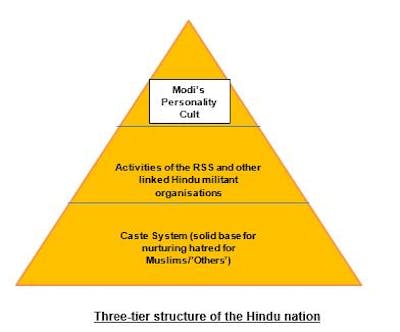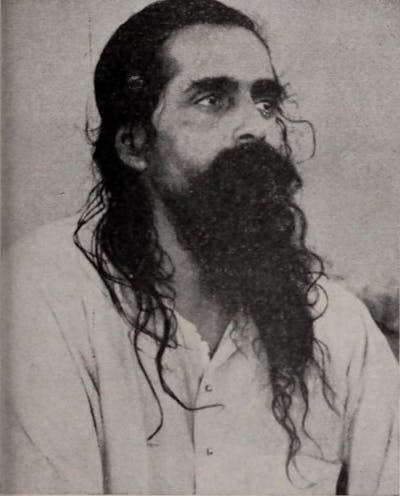How Narendra Modi’s cult of personality was formed by a powerful Hindu nationalist group with a dark history
Narendra Modi’s right-wing Bharatiya Janata Party (BJP) has resorted to religious polarisation as it tries to rally its Hindu nationalist base in India’s ongoing general election, which ends on June 1.
Just days after voting started last month, the leading opposition party accused Modi of using hate speech when he called Muslims “infiltrators” at a campaign rally.
He also repeated a conspiracy theory that Muslims would someday outnumber India’s majority Hindu population by having more children. If the opposition Congress returns to power, he added:
[it] will gather all your wealth and distribute it among those who have more children.
The Congress party has made no such commitments. But this claim has been repeated by BJP politicians during the campaign and featured in a video on the party’s Instagram account.
Many argue Modi’s openly anti-Muslim speeches reflect a sense of nervousness about the opposition gaining traction in the election. But there is no denying the fact the BJP has successfully created a perception of invincibility around itself. Why has it long had such a powerful image despite widespread economic distress?
To understand this, we need to look a bit closer at the history of right-wing populism in India.
How Hindu society has been formed
In my research, I have studied the way the modern “Hindu nation” has been constructed. In my view, there is a three-layered pyramid underpinning Modi’s popularity.
India’s centuries-old caste system serves as the base. This system survives on a principle of exclusion for the so-called lower castes and minorities.

The second layer is the Rashtriya Swayamsevak Sangh (RSS), the ideological mentor of the BJP. A Hindu nationalist paramilitary organisation, it was founded in 1925 as part of a movement to unite all Hindus.
On the topmost tier is Modi’s personality cult. The social legitimacy of Modi’s government is drawn from the base upwards, while the commands for his political project come from the top down.
The RSS plays an important role in this structure. It reinforces the cult of Modi by invoking Hindu scriptures and depicting him as the great redeemer of the Hindu religion. And the lower castes serve as the foot soldiers to do the RSS’s bidding.
Early influences of European fascism
The RSS was founded by upper-caste Hindus, led by a physician and Hindu nationalist, K.B. Hedgewar. While the stated aim was to strengthen Hindu values, Hedgewar consistently refused to participate in India’s freedom struggle against the British.
In the 1930s, Hindu nationalist leaders repeatedly expressed their admiration for Adolf Hitler and Benito Mussolini. The Hindu supremacist B.S. Moonje, Hedgewar’s mentor, even travelled to Italy in 1931 to meet Mussolini and members of a fascist youth organisation. Once back in India, Moonje wanted to militarise Hindu society using fascist models.
The RSS was never in agreement with Mahatma Gandhi’s efforts to reconcile the differences between Hindus and Muslims. In January 1948, an RSS member, Nathuram Godse, assassinated Gandhi. Although the organisation claimed Godse had quit before the shooting, the RSS was briefly banned by the government.
Growing power in Gujarat
Since its early days, one of the remarkable qualities of the RSS has been its methodical approach to its long-term vision.
It began establishing “shakhas”, or cells, in Gujarat, the present-day BJP stronghold, in the early 1940s. Its membership tripled from around 20,000 to 60,000 from 1943–48.
In the 1960s, the leaders of these cells began to preach about the virtues of an aggressive form of masculinity among Hindu men and alleged atrocities committed by Muslims against Hindu women. According to historian Megha Kumar, this “ideal Hindu man” was implicitly encouraged to commit sexual violence against Muslim women.
In December 1968, provocative speeches were given at a massive rally in Ahmedabad, presided over by M.S. Golwalkar, the second RSS chief, and attended by future Prime Minister Atal Bihari Vajpayee, the leader of the political party Bharatiya Jana Sangh, the predecessor of the BJP. The group recruited another 8,600 men in the next few months.

With resentment against the Muslims growing, violent riots broke out in September 1969, resulting in a large number of sexual assaults against Muslim women. Hundreds were killed.
This hardline religious nationalism started shaping Modi’s worldview after he joined the RSS in Gujarat at the age of eight. Having remarkable skills as an organiser, he rose through the ranks. By 1987, Modi’s responsibility was to act as the bridge between the RSS and the BJP, then a new political party.
Modi played key roles in facilitating roadshows to capitalise on Hindu-Muslim tensions, including a procession in 1990 in support of a new temple on the site of the historic 16th-century Babri Mosque. The mosque was destroyed by Hindu nationalists two years later.
Once the BJP came to power in Gujarat in 1995, the state machinery began recruiting RSS sympathisers to important posts. Backed by the RSS, Modi became chief minister in 2001.
This was followed by violent anti-Muslim riots in 2002, in which more than 1,000 people were killed. Modi was accused of complicity in abetting the riots, though a Supreme Court panel acquitted him later. He has denied accusations he failed to stop the rioting.
The BJP has not lost a Gujarat election since then.
The mass reach of the RSS today
Once considered a fringe group, the RSS and its ideology started to be accepted into mainstream Indian politics in the 1970s.
The BJP, in particular, needed the massive network of RSS cadres to mobilise Hindu voters. Even BJP candidates get selected based on feedback from RSS workers at the grassroots level.
Since coming to national power in 2014, the BJP has ensured that vice chancellors and professors appointed to public universities and universities in BJP-ruled states have come from the RSS.
And the organisation has penetrated almost every aspect of Hindu society. It runs a vast network of around 12,000 schools across the country, with more than three million students. These schools promote Hindu majoritarian values.
Textbooks are being revised at other schools with visible influence of the RSS. Darwin’s theory of evolution, a chapter on democracy and references to the 2002 Gujarat riots have been removed, for instance, as well as a chapter on the Mughals – the powerful Muslim dynasty that ruled India for three centuries.
Modi himself consults the RSS on important policy matters, too. When he presided over the inauguration of the controversial Ram Temple at the former Babri Mosque site in January, cricketing heroes and film actors shared the stage with RSS members.
In a surprise shift, however, the BJP has tried to distance itself from the RSS in recent weeks, suggesting that it doesn’t need it to win elections anymore. But it’s unlikely the party can do without the organisation’s network of grassroots workers.
The future of the world’s largest democracy seems to be in the firm hands of a group that believes it can establish a monolithic Hindu state. Only India’s multicultural ethos and secular traditions can stop this from happening.
This article is republished from The Conversation. It was written by: Aviroop Gupta, Curtin University
Read more:
How Modi is using TV, film and social media to sway voters in India’s election
Moments of hope: how Indians keep pushing back against the hollowing out of democracy
Extreme heatwaves in south and south-east Asia are a sign of things to come
Aviroop Gupta does not work for, consult, own shares in or receive funding from any company or organisation that would benefit from this article, and has disclosed no relevant affiliations beyond their academic appointment.

